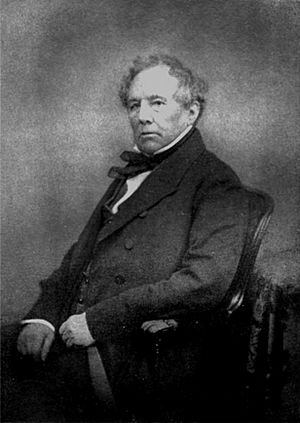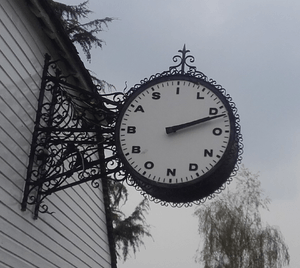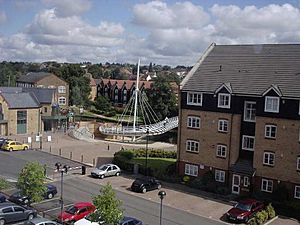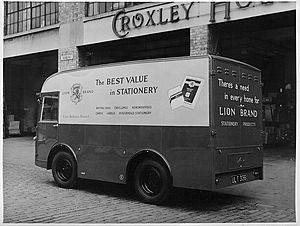John Dickinson Stationery facts for kids

John Dickinson Stationery Limited was a major English company that made stationery. It started in southwest Hertfordshire. In the 1800s, the company created many new ways to make paper. It joined the Dickinson Robinson Group in 1966. After changing owners several times, the John Dickinson name was no longer used after 2008.
Contents
History of John Dickinson Stationery
John Dickinson started his business in London in 1804. He had already been trying out new paper-making machines since 1802. In 1807, he got his first patent for cutting paper. Two years later, Dickinson patented a new way to make paper continuously by machine.
Early Mills and Growth
In 1809, Dickinson bought his first paper mill at Apsley, Hertfordshire. It was an old flour mill. In 1811, he bought a second mill nearby called Nash Mill. Both mills used water from the Grand Junction Canal. This canal also helped transport materials and products. Between 1828 and 1830, he built a third mill at Croxley Green, also by the canal.
Nash Mill became the home for Dickinson and his wife, Ann. Her father, Harry Grover, helped the business with money from his bank. Nash Mills became famous for making strong, thin paper. This paper was used for Samuel Bagster's "Pocket Reference Bible." A big fire in 1813 caused problems. But insurance money helped them rebuild for large-scale production.
Company Changes and Focus
Later in the 1800s, Sir John Evans and his son Lewis Evans managed the company. In 1885, John Evans left the company. The next year, it officially became John Dickinson & Co. Limited. It had a capital of £500,000.
Around this time, the company started to focus more on stationery. Making paper was not as profitable anymore. The Apsley factory was rebuilt to make envelopes. Paper production moved to the more modern Croxley Mill.
John Dickinson & Co. Ltd had its own engineering team at Nash Mills until 1888. This team slowly moved to Apsley Mill. By 1903, it was just a repair shop. Nash Mill was small and had its own way of doing things. Its profits dropped by the end of the 1800s. It was updated and expanded in 1926. The Lion Brand became the company's logo in 1910.
Basildon Bond Stationery
The Basildon Bond brand of stationery started in 1911. It was created by Millington and Sons. The name comes from Basildon Park. Some of Millington's directors were staying there. They liked how "Basildon" sounded with "bond" (a type of paper). John Dickinson bought Millington & Sons in 1918. This is how they got the Basildon Bond brand.
Key Innovations in Papermaking
John Dickinson patented a new way of papermaking in June 1809. This method made older techniques, like the Fourdrinier machine, less useful. In 1850, the company began making envelopes by machine. These were the first gummed envelopes. Nash Mill also successfully made fine paper using electrically powered machines.
Contributions During World War II
During the Second World War, the company made many paper and cardboard products for the war effort. They also started making engineering items. These included fuel tanks for long-range fighter planes. They also made 20 mm cannon shells and aircraft fuel pumps. The company even made the foil strips called Window. The RAF used these to confuse enemy radar.
Dickinson Robinson Group and Later Years
The Dickinson Robinson Group Ltd (DRG) was formed in 1966. It combined E. S. & A. Robinson Packaging and John Dickinson & Co Ltd. This created one of the world's largest stationery and packaging companies.
In 1989, Roland Franklin bought DRG for £900 million. He then sold off its different parts for a profit.
- In 1990, the paper mills were sold to Sappi of South Africa. These mills were later closed by Sappi.
- Also in 1990, DRG Stationery was bought by a Swiss company. It was renamed John Dickinson Stationery. After some changes, it was bought by Spicers Ltd in 1996. It moved to Sawston. In 2005, a French company, Hamelin Group, bought John Dickinson Stationery. In 2008, it was renamed Hamelin Brands and moved to Red Lodge, Suffolk.
- In 1992, DRG Packaging was bought by Bowater plc.
Frogmore Paper Mill
Just north of the old Apsley Mill site is Frogmore Paper Mill. This is the world's oldest paper mill that uses machines. It was here that Bryan Donkin first showed the papermaking machine he made. A charity now runs it for conservation and education. It is still working today.
Black n' Red Products
Black n' Red is a brand of books and paper pads. They were made by John Dickinson Stationery Limited. These products have a cool black and red design. The covers are black, with "Black n' Red" written in red. The spine of the book is also red. These books are now sold by the Oxford brand within the Hamelin Group.







